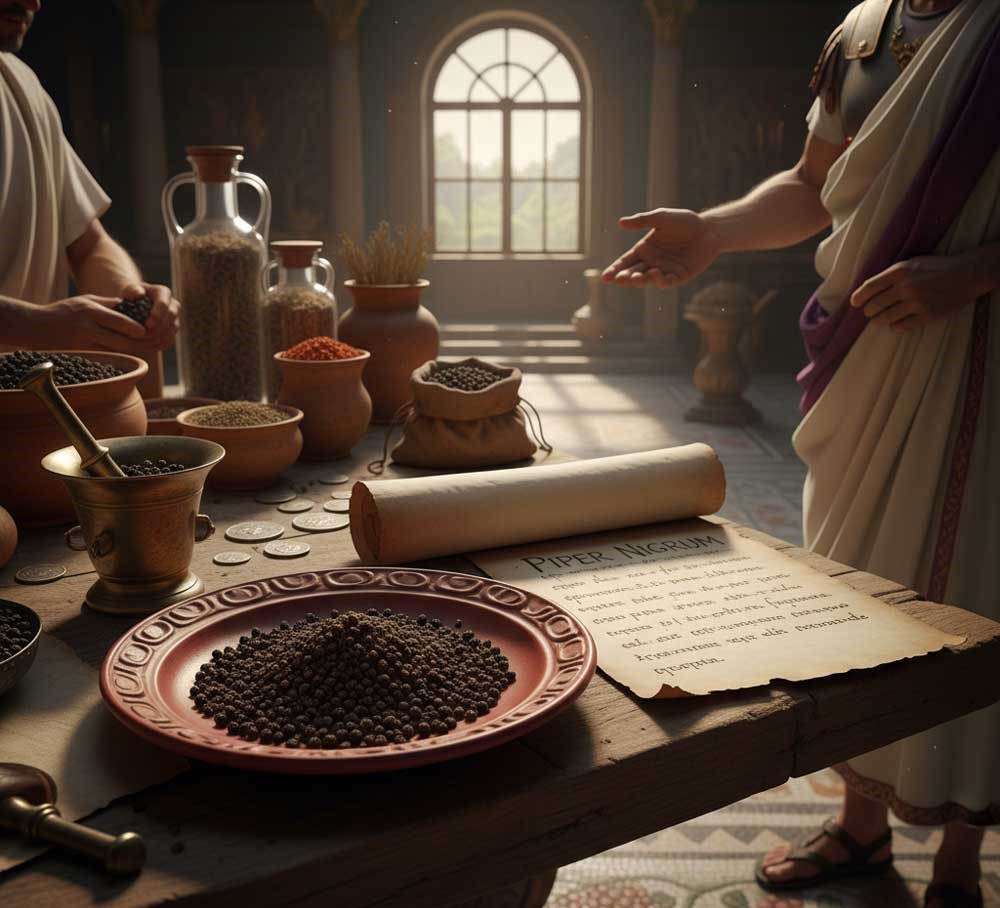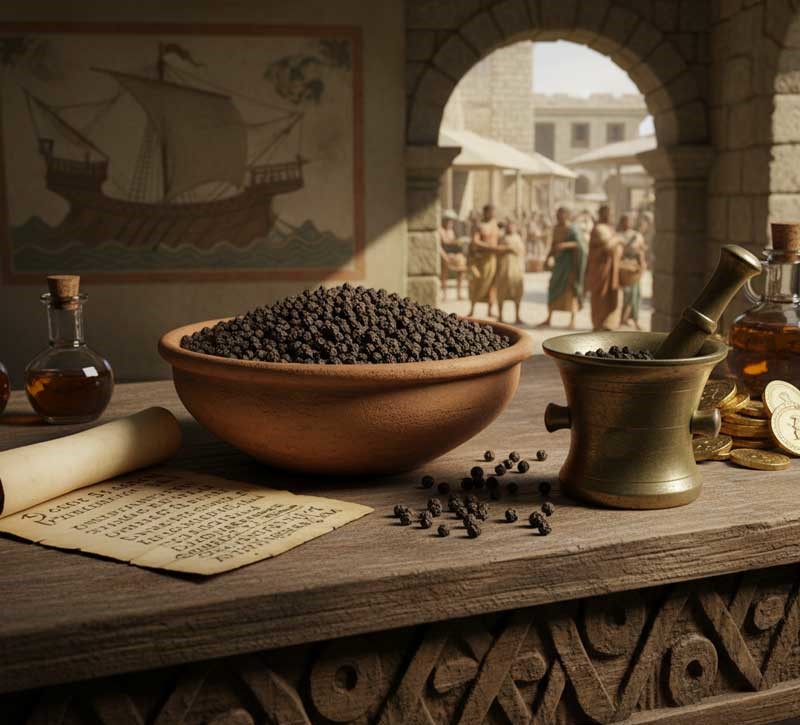Imagine you’re a merchant on the quays of Myos Hormos on the Red Sea coast. The sun is a hard white coin in the Egyptian sky. Bales of glassware and amphorae of wine clink and slosh as stevedores shout in Greek and Latin. You are waiting—not for grain, not for olive oil, but for little black beads that Romans will weigh as carefully as silver: piper, black pepper. In a few weeks, when the monsoon turns, your ship will ride the winds across the open ocean to India, and—if the gods smile—you’ll return with a cargo Rome cannot get enough of.

Pepper was the quiet obsession of the Roman palate. To modern diners, it’s a ubiquitous hum on almost every plate; to Romans, it was a luxury that climbed from the banqueting halls of the elite into the kitchens of soldiers and shopkeepers on the empire’s edges. The journey of those peppercorns—botanical seeds from a vine on the Malabar Coast of India—to a wooden table in a Trastevere tavern is a story of winds and wealth, snobbery and science, and the irresistible tug of taste.
A Taste Worth Sailing For
Roman writers loved to sneer at luxury, and pepper took plenty of literary flak. Pliny the Elder, encyclopedist and moralist, was baffled: pepper has no perfume, no beauty, just bite—so why, he grumbled, do we sail all the way to India and then buy it by weight like gold? Even as he catalogued the grades and prices—long pepper costliest, black pepper cheapest—his exasperation tells us something crucial: pepper was everywhere enough in Rome to irritate a man who disapproved of extravagance.
The cookbook traditionally attributed to Apicius drives the point home. In this compendium of Roman cooking, pepper appears in most recipes—pounded into sauces, dusted over meats, married to wine, honey, and garum. When modern editors totted them up, pepper figured in roughly 70–75% of the dishes. That’s not a flourish of exoticism; that’s a pantry staple.
Pepper’s path to ubiquity was paved by empire. After Augustus took Egypt in 30 BCE, Rome inherited the shortest staircase to the Indian Ocean. Within a generation, ships were sailing regularly from Red Sea ports to the Malabar Coast, timing their departures to the seasonal monsoon winds that could waft them straight across open water. The anonymous Periplus of the Erythraean Sea—a mariner’s handbook—reads like a pilot’s log of that commerce, listing ports such as Muziris and what to expect (and buy) there. Chief among those goods: black pepper.
The winds themselves became part of the lore. Later tradition credits a navigator named Hippalus with recognizing how to ride the monsoon directly to India, compressing journeys that once hugged coasts into daring ocean crossings. Whether or not Hippalus deserves all the glory, the route he symbolizes filled Roman markets with pepper, pearls, and textiles—and filled Indian temples and treasuries with Roman gold.
“Gold for Pepper”: Counting the Cost
Pliny did more than fume; he counted. In some passages he lamented that India, Arabia, and China drained the empire of perhaps one hundred million sesterces a year, with India alone taking half—an outflow he saw as both economic and moral peril. Scholars debate the numbers, but the literary pose is clear: the spice trade was big enough to be noticed at the highest levels of Roman culture and government.
Two centuries later, the anxiety about prices had a legal echo. In 301 CE, Emperor Diocletian issued his famous Edict on Maximum Prices, setting ceilings on more than a thousand items and wages across the empire. Among the listed commodities: spices like pepper. The edict’s fragments—inscribed on stone in Greek and Latin—don’t prove that pepper became cheap; they prove it was significant enough to regulate. (The edict itself was a doomed attempt to tame inflation, but it leaves a precious price snapshot.)
Recent scholarship goes further, challenging the old trope that pepper was a bauble for the super-rich. Economic historians have compared prices and wages to show that at least small quantities of pepper were within reach of middling consumers, especially in the early imperial period. Pepper was still a marker of taste—but not necessarily an unattainable one.

From Muziris to the Market: How Pepper Moved
If Pliny gave Rome a moral commentary on pepper, the Periplus gave captains a practical one. It described the how: merchants loaded ships at Myos Hormos or Berenice; crossed the Arabian Sea on the southwest monsoon; bartered at bustling Indian emporia like Muziris; and rode the northeast monsoon home. Archaeology and papyrology now add the who and how much. The so‑called Muziris Papyrus, a mid‑second‑century shipping and loan dossier, preserves a customs assessment for a returning cargo and a contract that financed a voyage. It shows pepper amid a mix of valuable goods and clarifies the taxes, lenders, and legal frameworks that underwrote these high‑risk, high‑reward trips.
Behind each sack of pepper was an international workforce: shipowners and pilots, intermediaries and tax-farmers, brokers fluent in Greek, Latin, and local languages, and diaspora communities who reduced the frictions of long‑distance trade. Newer research frames this as a complex “game” of Indo‑Mediterranean commerce, where states and private actors collaborated and competed, all to keep pepper (and coin) moving.
The Roman Imagination: Love the Flavor, Hate the Luxury
Satirists and moralists treated pepper as an emblem of excess. Yet the sneer often masked familiarity. Martial jokes about cooks turning bland beet greens into lunch with pepper and wine—hardly an emperor’s banquet dish. Pliny himself couldn’t stop talking about pepper; he mentions it dozens of times in his Natural History. The more Romans scolded pepper as a luxury, the more it seems to have seasoned their lives. Recent literary analysis calls this the “pepper paradox”: a spice derided in elite rhetoric yet pervasive in practice.
The city even built monumental spaces to advertise its command of the spice world. The Flavian Templum Pacis—with its famed horrea piperataria, or pepper warehouses—stood as a kind of imperial boast: Rome could marshal the farthest botanicals of the earth and stack them beside the Sacred Way. In this vision of “botanical imperialism,” pepper wasn’t just a taste; it was a trophy.
Plates, Prescriptions, and… Ports of Call
So what did Romans actually do with pepper? Almost everything. In the kitchen, pepper sharpened sauces for pork, lamb, and fish; perfumed stews thickened with wheat starch; and balanced sweet‑savory recipes in which honey met vinegar, wine, and garum. The Apicius repertoire is full of that interplay: pounded pepper with cumin and lovage, bound with wine and oil, spooned over meats or vegetables.
But pepper also straddled the border between food and medicine. Medical writers ascribed to it warming, stimulating properties. It entered remedies (some stomach‑turning) for colic, menstrual irregularities, and more; it was even roped into animal husbandry in some odd prescriptions. If it sounds like “pepper for everything,” that’s because pepper’s pungency and perceived heat made it a go‑to ingredient in humoral medicine.
The physical peppercorns have turned up in surprising places, too. Archaeologists have recovered pepper from desert port towns like Berenike on the Egyptian Red Sea coast and in damp cesspits from Britain to Germany—quiet proof that the spice had traveled far beyond palaces and senatorial villas.
Could Ordinary Romans Afford Pepper?
This is the question that teases every discussion. The short answer is: sometimes, and in small amounts. Price lists (like Diocletian’s), literary complaints (like Pliny’s), and the sheer volume of shipping (Strabo famously claimed “120 ships” sailed annually from Egypt to India in his day) all hint that pepper wasn’t a once‑in‑a‑lifetime flavor. While tanker‑loads of pepper fed elite banquets and the retail trade of Rome’s central spice market, pinches of it filtered to frontier forts and provincial towns. Evidence from Roman Britain—Vindolanda’s letters talk about socks and sandals rather than spices, but the site’s cesspits elsewhere in the province have yielded traces of pepper—speaks to a broad, if thin, distribution.
Recent economic studies using the Muziris Papyrus and wage/price comparisons suggest pepper could be an occasional purchase outside the very top tier. Not daily fare for the poor—but not locked behind palace doors either. Call it a “reachable luxury,” consumed as much for its social signal as its sting.

Why Pepper, Not Something Else?
Long pepper (Piper longum)—hotter, rarer—also circulated in Rome, and Pliny priced it above black and white pepper. But black pepper (Piper nigrum), cultivated in southwestern India, had the logistical advantage of supply. It dried and shipped well, arrived in bulk, and delivered reliable heat that Roman cooks could count on. Over the centuries, it would outlast long pepper in European kitchens. In Roman texts, though, both appear—another sign of a sophisticated, differentiated spice market.
There was also the theater of origins. Greeks and Romans inherited tall tales about spices guarded by snakes and gathered at peril—part marvel, part marketing. Pepper, blackened (so the story went) by the flames used to drive off serpents, fit neatly into this exoticizing lore. Such myths amplified pepper’s aura; a little bowl on the table whispered of far coasts and dangerous forests.
The Aftertaste of Empire
Follow a last handful of peppercorns back along the chain. From a Roman tavern they trace to a market near the Forum, then to the horrea piperataria by the Templum Pacis; from there to Ostia’s port, to river barges up the Tiber, to large sea‑going hulls hugging the coast to Alexandria; to camel caravans across the Eastern Desert; to Red Sea harbors where monsoon‑ready ships waited; to Muziris, where pepper changed hands for wine, glass, and gold coin—and back again. It’s a circuit that taught Romans to time their economy to Indian Ocean weather, to write contracts for transoceanic risk, to invent fiscal tools and customs categories just for Eastern cargoes. Pepper didn’t just sharpen sauces; it sharpened the empire’s commercial instincts.
Pliny might have scolded, Diocletian might have fixed prices, and satirists might have rolled their eyes—but cooks kept grinding, merchants kept sailing, and pepper kept pouring out of sacks and into mortars. In the end, Rome’s black gold was not marble or marble‑smooth rhetoric. It was that tiny, wrinkled berry whose trail stitched the Mediterranean to the monsoon seas and whose bite told every diner, rich or poor, that the world was bigger—and closer—than they had imagined.
Want to sprinkle in a few primary‑source flavors at your next dinner party?
- Pliny the Elder, Natural History: baffled sermonizing plus practical details on types and prices of pepper; priceless for understanding Roman attitudes.
- Periplus of the Erythraean Sea: a sailor’s manual to the Indo‑Roman sea lanes, with Muziris and pepper front and center.
- Apicius, De re coquinaria: where you can taste the Roman love affair with pepper across hundreds of recipes.
- Muziris Papyrus: a customs assessment and loan contract that lets you peek at the spreadsheets behind the spice.
- Modern syntheses: on how “gold for pepper” reshaped economies and diasporas.